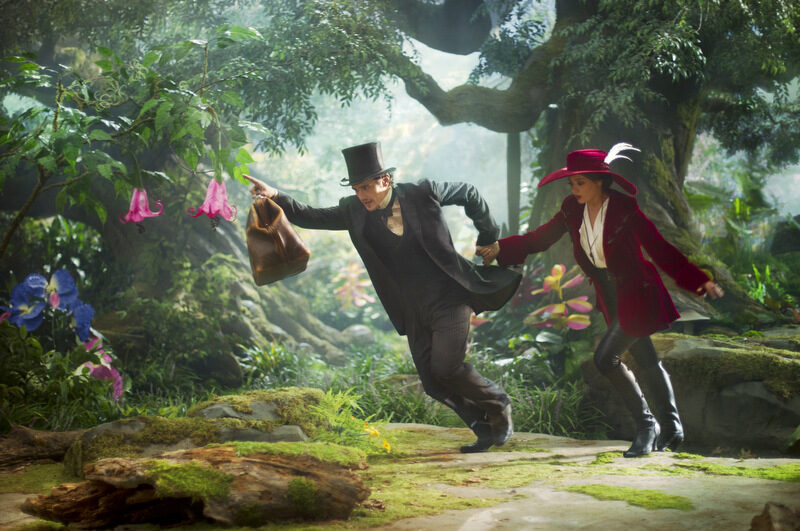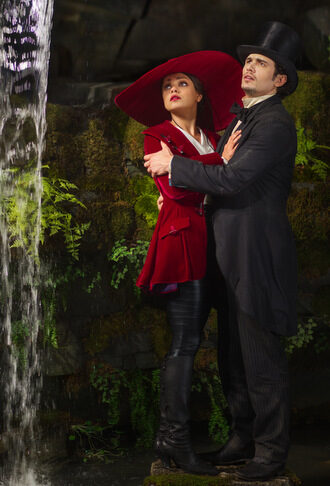Review: Oz the Great and Powerful |
 © 2013, Walt Disney Pictures 4 Mar ’13
© 2013, Walt Disney Pictures 4 Mar ’13
Starring: James Franco, Mila Kunis, Rachel Weisz
Directed By: Sam Raimi
There is a cute line early on in Oz the Great and Powerful. The screen is black and white, pre land of Oz with the boxy ratio of an old television set. Circus illusionist Oscar (James Franco) is told by the one that got away (Michelle Williams) that she can no longer wait for him. He strokes the fabric on her dress, “Is this gingham?” he inquires. We are back in Kansas.
Oz the Great and the Powerful is a prequel to The Wizard of Oz, not a remake. It lays the groundwork for all that befell poor Judy Garland’s as Dorothy taped down in that gingham pinafore back in 1939. It’s an origin story for where the wizard and wicked witch came from – a question you probably never considered asking. Give the answer a chance though, because while it may be as patchy as a patchwork quilt, Oz the Great and Powerful is equally pleasing to look at. It is more feature length theme park ride than movie. The 3D is so convincing you will squint (arrows), grasp (snowflakes) and prey it’ll be over soon (waterfall) – but in a good way. Anyone who remembers Cinema 180 at Thorpe Park but felt perhaps it needed A-list stars and a narrative is in for a treat.
Even though Oscar (James Franco) wears the same Victorian walking coat throughout Oz the Great and Powerful it has three levels of distressing, starting with pulls and a split shoulder seam and ending in near pristine condition. It is not something drawn attention to within the narrative, but a reflection of Oscar’s deep character evolving throughout.
Casting is not one of the film’s strong points as no-one embraces the material with enough gusto. Franco always looks as though he is staring off camera at something more interesting. Mila Kunis’ Theodora is only convincing before (spoiler) her transformation – a wicked witch screaming at the top of her lungs in a thick New York accent is funny not scary. Her physicality too is not bony and spiky enough. Williams’ Glinda the Good is okay; sort of mumsy and cuddly, yet not soppy as she could have been. But only Rachel Weisz as naughty big sister Evanora revels completely in the silliness, and even she could have cranked it up a notch. Zach Braff is surprisingly solid voicing a monkey bellhop with a face like Bungle.
Costume designer Gary Jones working in a collaboration with (and from sketches by) character illustrator Michael Kutsche blinds Oz with colour. The look is a blend of period (late Victorian/early 20th century), classic fantasy and contemporary trends. Ironically the latter element is to help us accept the land of Oz as a parallel of our own. However, glimpsing long leather boots on Glinda as she is hauled across the ground by the evil sisters is akin to seeing a supermodel topple over on the catwalk. Williams is wearing change 3 of her costumes at this point – the ‘armour’ bodice, so white boots do make contextual sense even if sparkly shoes would have fit more comfortably within what we expect of the genre. The same can be said of Theodora’s risky first outfit, a red velvet coat, matching wide floppy brim hat and what appear to be tight leather pants with light pintucking. Although this is intended as a riding costume we are unfortunately never shown what she was riding. When Theodora dances with Oscar the snug fit posterior of her jodhpur pants is very noticeable. Not jarring, just different – sort of wearable fantasy rather than runway haute couture. Jones’ clothes are beautiful and practical, as delightful moving, flying, standing or sitting, so who is to say this is not the jolt the genre needed? Normally we appreciate the beauty of fantasy costumes; here we are thinking about them too.
Glinda (Michelle Williams) is a witch the same as Evanora (Rachel Weisz), yet completely opposes her in character and clothing. Williams wears three white dresses throughout the film, compared to Weisz’s one (with added leggings for the finale): show-stopping shimmer silk, a more armour like feather and silver lamé, and multi-layered tulle in pink and white. All dresses feature a Regency-esque v-shape bodice.
Although patchy in terms of tone and pacing, Oz the Great and Powerful feels coherent overall. Evidently director Sam Raimi was keen to amalgamate his technical departments wherever possible, hence the apparently unusual step of hiring a character illustrator as co-costume designer. Rami’s idea was that Michael Kutsche could create his world on paper then Gary Jones would bring it to life in fabric. Jones also worked closely with production designer Robert Stromberg to make the costumes integrate with Oz. Even the giant Prussian inspired Winkie guards fit in the repressed, buttoned up habitat around them. Simple techniques such as Evanora’s green sequin and crystal dress help connect her with the Emerald City. Colour is a delicate tool because meaning depends on context and cultural significance, although here we don’t need to think beyond the obvious. Glinda wears white silk and tulle because she is soft and good, Theodora begins the story in red as a warning foreshadowing her future, i.e. the fire within, and Oscar’s black walking coat is a period choice but also identifies him as alien in a foreign land. It is swift and effective costume language.
Despite reshoots, budget panics and all sorts of ultimately irreverent bad press, Raimi has made his return to Oz worth popping on the 3D glasses for. His name is all over this film with familiar directorial touches (extreme facial close ups, split screen) that thankfully feel more his Darkman days than Spider-Man. If you did not want Oz the Great and Powerful, too late it has happened now, so you may as well enjoy it.
Oz the Great and Powerful is released on 8th March.
© 2013, Chris Laverty.

